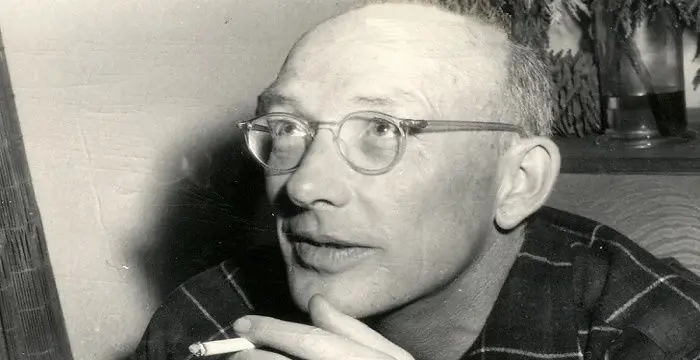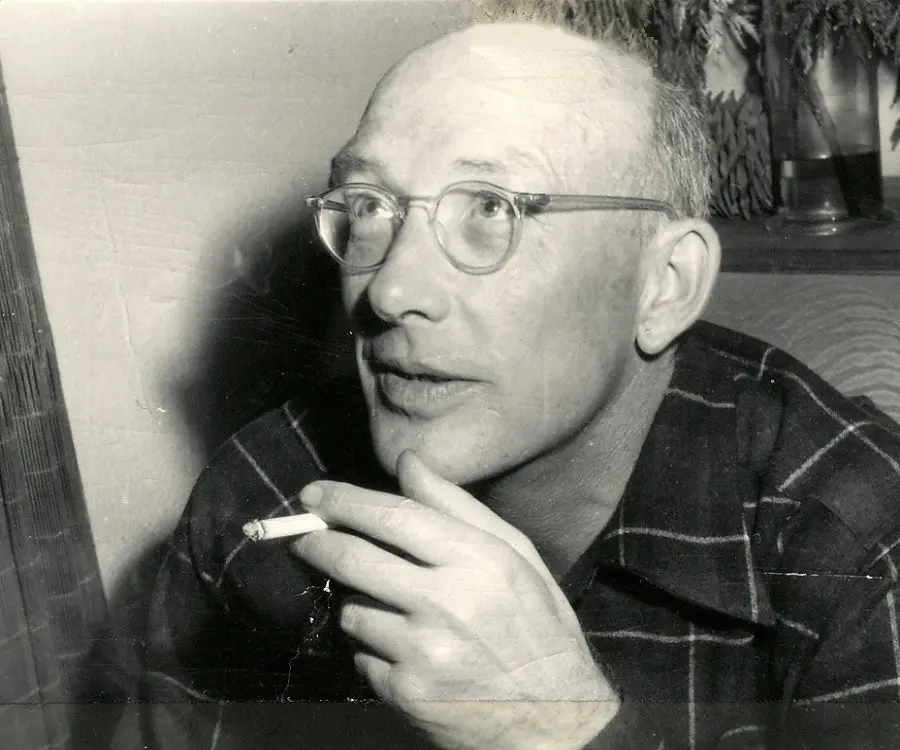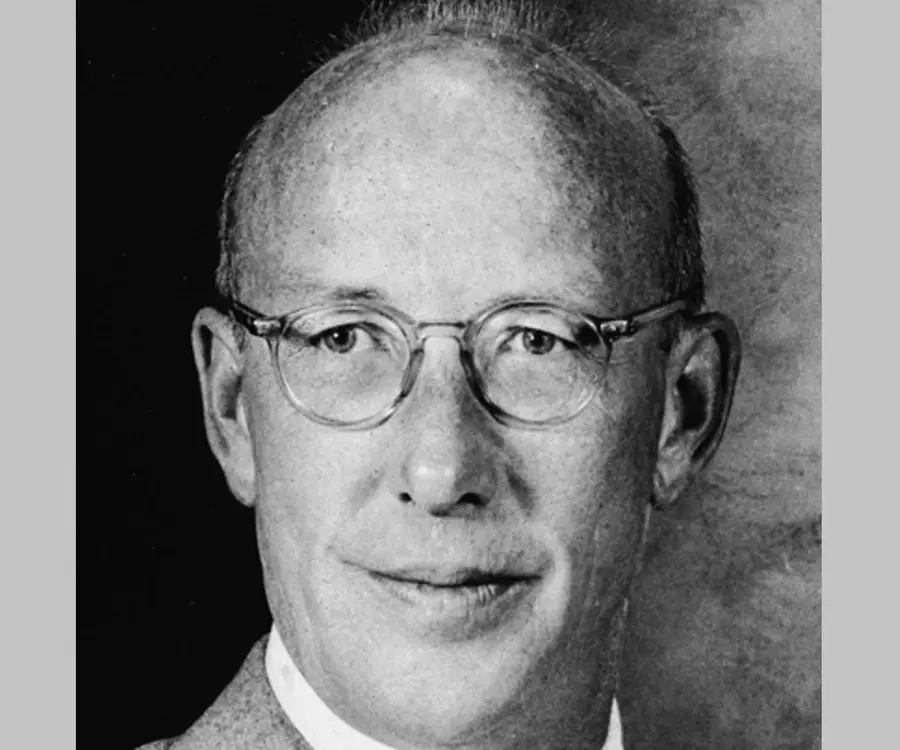
Edward Lawrie Tatum - Biochemists, Life Achievements and Personal Life
Edward Lawrie Tatum's Personal Details
Edward Lawrie Tatum was an American biochemist who won the 1958 Nobel Prize in Medicine
| Information | Detail |
|---|---|
| Birthday | December 14, 1909 |
| Died on | November 5, 1975 |
| Nationality | American |
| Famous | University Of Chicago, Scientists, Biochemists |
| Universities |
|
| Notable Alumnis |
|
| Birth Place | Boulder, Colorado, United States |
| Gender | Male |
| Sun Sign | Sagittarius |
| Born in | Boulder, Colorado, United States |
| Famous as | Biochemist |
| Died at Age | 65 |
// Famous University Of Chicago
Satya Nadella
Satya Nadella is the current CEO of Microsoft. This biography provides detailed information about his childhood, profile, career, net worth & timeline
Emily Greene Balch
Emily Greene Balch was an American economist, sociologist and pacifist who won the 1946 Nobel Peace Prize. This biography of Emily Greene Balch provides detailed information about her childhood, life, achievements, works & timeline.
Susan Sontag
Susan Sontag is an American critical essayist, cultural analyst, novelist, political activist, filmmaker and playwright of international repute. Read on to find out more about her childhood, career, profile and timeline.
Edward Lawrie Tatum's photo
Who is Edward Lawrie Tatum?
Edward Lawrie Tatum was an American biochemist who along with George Wells Beadle won the 1958 Nobel Prize in Medicine for showing that genes control individual steps in metabolism. Born in Colorado, initially, he followed his father’s footsteps to study chemistry at the graduation level; then took up microbiology for his postgraduate degree and biochemistry for his PhD. His hybrid educational qualifications later affected his career. Nonetheless, his talent was recognized by his professors, who recommended him to Professor Beadle, while he was working on Drosophila at the University of Stanford. Afterwards the two scientists worked on Neurospora and established the ‘one gene – one enzyme’ theory, which earned them their Nobel Prize. Meanwhile Tatum had to leave Stanford because he was an Assistant Professor in the Biology department with a degree in chemistry. Subsequently, he shifted to University of Yale as Assistant Professor in Botany and began working on bacteria with another Nobel winning scientists Joshua Lederberg, whom he had also mentored. Subsequently, they established that E-coli bacteria entered a sexual phase, during which it could pass on genetic information. At last the University of Stanford invited him back as a full professor at the Department of Biology. Later, he held many important positions and served in different capacities till his death.
// Famous Scientists
Juliane Koepcke
Juliane Koepcke is a German-Peruvian biologist, who was the lone survivor among the 92 passengers and crew of the ill-fated LANSA Flight 508 that crashed in the Peruvian rainforest on 24 December 1971. Know more about her life in this biography.
Henry Cavendish
Henry Cavendish was a theoretical chemist and physicist, renowned for discovery of hydrogen and calculation of the mass of earth. To know more about his childhood, profile, timeline and career read on
Konstantin Tsiolkovsky
Konstantin Tsiolkovsky was a Russian rocket scientist and a pioneer of astronautics. This biography provides detailed information about his childhood, family, personal life, career, achievements, etc.
Childhood & Early Years
Edward Lawrie Tatum was born on 14 December 1909, at Boulder, Colorado. At the time of his birth, his father, Arthur Lawrie Tatum, was an instructor in chemistry at the University of Colorado. Later he earned his degrees and became a Professor of Pharmacology.
Edward’s mother, Mabel Webb Tatum, died while he was a child. His father later married Carla Harriman. Edward was the first surviving son of his parents. His twin, Elwood, died soon after the birth. He had two younger siblings; a brother named Howard J. Tatum and a sister named Besse C Tatum.
For greater part of his life, Arthur held different teaching positions in different universities in the Midwest. Therefore, while Edward was growing up, the family was moving from place to place. However, they always had a scientific environment at home, which helped grow his aptitude towards science.
From 1918 to 1928, Arthur was engaged at the University of Chicago. During this period, Edward studied at the University of Chicago Laboratory School and graduated from there in and around 1926.
Afterwards, Edward enrolled at the University of Chicago. But when after two years, his father moved to the University of Wisconsin Medical School as Professor of Pharmacology Edward shifted with him.
Ultimately, he earned his bachelor degree in chemistry from the University of Wisconsin, in 1931. He then went on to earn M.S. degree in microbiology, in 1932, and PhD in biochemistry, in 1934, from the same university.
For his doctoral thesis, he chose to work on the nutrition and metabolism of bacteria. He soon established that microorganisms needed thiamine, also known as Vitamin B1, to grow. The thesis, which earned him his PhD, also laid the ground for his future work, which he undertook with G. W. Beadles.
Career
After receiving his PhD, Edward Tatum remained at the University of Wisconsin for a year and then in 1935, he went to Holland for his postdoctoral work receiving a General Education Fellowship at the University of Utrecht. There he worked on identifying growth factors in staphylocci, but was not very successful.
Subsequently, he returned to the University of Wisconsin and remained there till 1937. Sometime now, he was invited by Professor George W. Beadles to join him in his work on Drosophila at the University of Stanford, California.
Tatum also got an offer to work on the microbiology of butter. Although his father wanted him to take that up, Tatum joined Beadle’s team at the Department of Biological Sciences at the University of Stanford as Research Associate without teaching responsibility, in 1937.
He first concentrated on extracting pigments precursors from the larvae of Drosophila. By 1941, he was successful in isolating the V+ hormone in a crystalline state from bacterial culture and identified it as kynurenine.
Unfortunately, Adolf Butenand, who was working on this independently, preceded him in this discovery and so Tatum received no credit for his work. Jarred by this experience he and Beadle decided to look for another model and chose Neurospora crassa.
By February 1941, Tatum and Beadle began exposing Neurospora to X-ray in order to obtain mutants that would have biochemical defects because of nutritional deficiency. Ultimately, it was the mutant number 299, which was the first identifiable mutant that required pyridoxine for normal synthesis.
Subsequently, they obtained hundred of mutants which were deficient in nutrition and began working on them. By May 1941, they were ready to submit their first report, in which they concluded that “the gene and enzyme specificities are of the same order”.
Later in the same year, they proposed a direct link between gene and enzymes, which led to the establishment of ‘one gene-one enzyme’ hypothesis. Although the theory has been refined by later scientists, it remains the same in essence.
In the winter of 1941, Tatum was promoted to the post of Assistant Professor. He then volunteered to develop and teach biochemistry course to both biology and chemistry students. However, because he was a chemistry graduate working in the biology department, his position became more and more shaky.
Tatum left the University of Stanford in 1945 to join University of Washington at St. Louise. But after a semester he shifted to the University of Yale as Assistant Professor of Botany. Here he developed biochemically oriented microbiological course at the Department of Botany. Later, he became Professor of Microbiology in the same institute.
In 1946, Tatum, with Joshua Lederberg, began to work on bacteria. They used the same methodology, which Tatum had used on Neurospora and subsequently, discovered Escherichia coli bacteria of the K-12 strain entered a sexual phase, during which it could pass on genetic information.
In 1948, he returned to the University of Stanford as a full Professor in the Department of Biology. Here, he mostly pursued and supervised different biochemical projects. Later, when the School of Medicine was being reconstructed at the University premises Tatum helped to develop its curriculum.
In 1956, he was appointed head of the newly formed Department of Biochemistry. During this time the Institution became a major center of scholarship. However, for personal reason he left Stanford to join Rockefeller Institute towards the end of the year.
At the Rockefeller Institute, he concentrated on institutional affairs. At the same time, he also retained his interest on Neurospora and encouraged his students to nurture their own idea. In fact, he took more pride in their accomplishments than his own.
Towards the end of his career, he devoted considerable amount of time on national science policy and worked hard to strengthen fellowship programs. For some time, he also served as the Chairman of the Board at the Cold Spring Harbor Biological Laboratory.
Major Works
Tatum is best remembered for his work with George W. Beadle on Neurospora. After observing innumerable mutants over a long period, they came to the conclusion that “A single gene may be considered to be concerned with the primary control of a specific chemical reaction”. Their theory, later dubbed as ‘one gene-one enzyme hypothesis’, elped create the field of molecular genetics.
Tatum is also remembered for his work on bacteria at the University of Yale. It was largely because of his work, that bacteria began to be considered as the main source of information for gaining insight into how biochemical process is controlled by genetics.
Awards & Achievements
In 1958, Edward Lawrie Tatum and George Wells Beadle received Nobel Prize for Physiology or Medicine "for their discovery that genes act by regulating definite chemical events". Incidentally, the prize was co-shared by Joshua Lederberg, whom Edward had mentored at the University of Yale while they were working on recombination of bacteria.
Personal Life & Legacy
Tatum first married June Alton on 28 June 1934. The couple had two daughters, Margaret and Barbara. They divorced sometime in 1956.
On 16 December 1956, Tatum married Viola Kanter. They remained married until her death on 21 April 1974. Later that year, he tied the knot for the third time and married Elsie Bergland. They remained married until his death shortly after.
Tatum was a heavy smoker and suffered from chronic emphysema. He died on 7 November 1975, from heart failure.
// Famous Biochemists
Robert Huber
Robert Huber is a German biochemist and Nobel Laureate. Check out this biography to know about his childhood, life, achievements, works & timeline.
Charles Best
Charles Best was a great scientist and a renowned physiologist who is remembered for being the co-discoverer of insulin. Read this biography to learn about his profile, childhood, life and timeline.
Isaac Asimov
Isaac Asimov was an American professor of biochemistry and a renowned author of science fiction and popular science books. Read this biography to know more about his life.
Edward Lawrie Tatum's awards
| Year | Name | Award |
|---|---|---|
Other | ||
| 0 | Nobel Prize in Physiology or Medicine | |
Edward Lawrie Tatum biography timelines
- // 14th Dec 1909Edward Lawrie Tatum was born on 14 December 1909, at Boulder, Colorado. At the time of his birth, his father, Arthur Lawrie Tatum, was an instructor in chemistry at the University of Colorado. Later he earned his degrees and became a Professor of Pharmacology.
- // 1918From 1918 to 1928, Arthur was engaged at the University of Chicago. During this period, Edward studied at the University of Chicago Laboratory School and graduated from there in and around 1926.
- // 1931Ultimately, he earned his bachelor degree in chemistry from the University of Wisconsin, in 1931. He then went on to earn M.S. degree in microbiology, in 1932, and PhD in biochemistry, in 1934, from the same university.
- // 28th Jun 1934 To 1956Tatum first married June Alton on 28 June 1934. The couple had two daughters, Margaret and Barbara. They divorced sometime in 1956.
- // 1935After receiving his PhD, Edward Tatum remained at the University of Wisconsin for a year and then in 1935, he went to Holland for his postdoctoral work receiving a General Education Fellowship at the University of Utrecht. There he worked on identifying growth factors in staphylocci, but was not very successful.
- // 1937Subsequently, he returned to the University of Wisconsin and remained there till 1937. Sometime now, he was invited by Professor George W. Beadles to join him in his work on Drosophila at the University of Stanford, California.
- // 1937Tatum also got an offer to work on the microbiology of butter. Although his father wanted him to take that up, Tatum joined Beadle’s team at the Department of Biological Sciences at the University of Stanford as Research Associate without teaching responsibility, in 1937.
- // 1941He first concentrated on extracting pigments precursors from the larvae of Drosophila. By 1941, he was successful in isolating the V+ hormone in a crystalline state from bacterial culture and identified it as kynurenine.
- // 1941In the winter of 1941, Tatum was promoted to the post of Assistant Professor. He then volunteered to develop and teach biochemistry course to both biology and chemistry students. However, because he was a chemistry graduate working in the biology department, his position became more and more shaky.
- // Feb 1941By February 1941, Tatum and Beadle began exposing Neurospora to X-ray in order to obtain mutants that would have biochemical defects because of nutritional deficiency. Ultimately, it was the mutant number 299, which was the first identifiable mutant that required pyridoxine for normal synthesis.
- // May 1941Subsequently, they obtained hundred of mutants which were deficient in nutrition and began working on them. By May 1941, they were ready to submit their first report, in which they concluded that “the gene and enzyme specificities are of the same order”.
- // 1945Tatum left the University of Stanford in 1945 to join University of Washington at St. Louise. But after a semester he shifted to the University of Yale as Assistant Professor of Botany. Here he developed biochemically oriented microbiological course at the Department of Botany. Later, he became Professor of Microbiology in the same institute.
- // 1946In 1946, Tatum, with Joshua Lederberg, began to work on bacteria. They used the same methodology, which Tatum had used on Neurospora and subsequently, discovered Escherichia coli bacteria of the K-12 strain entered a sexual phase, during which it could pass on genetic information.
- // 1948In 1948, he returned to the University of Stanford as a full Professor in the Department of Biology. Here, he mostly pursued and supervised different biochemical projects. Later, when the School of Medicine was being reconstructed at the University premises Tatum helped to develop its curriculum.
- // 1956In 1956, he was appointed head of the newly formed Department of Biochemistry. During this time the Institution became a major center of scholarship. However, for personal reason he left Stanford to join Rockefeller Institute towards the end of the year.
- // 16th Dec 1956 To 21st Apr 1974On 16 December 1956, Tatum married Viola Kanter. They remained married until her death on 21 April 1974. Later that year, he tied the knot for the third time and married Elsie Bergland. They remained married until his death shortly after.
- // 1958In 1958, Edward Lawrie Tatum and George Wells Beadle received Nobel Prize for Physiology or Medicine "for their discovery that genes act by regulating definite chemical events". Incidentally, the prize was co-shared by Joshua Lederberg, whom Edward had mentored at the University of Yale while they were working on recombination of bacteria.
- // 7th Nov 1975Tatum was a heavy smoker and suffered from chronic emphysema. He died on 7 November 1975, from heart failure.
// Famous Sagittarius Celebrities peoples
Billie Eilish
Billie Eilish Pirate Baird O’Connell is an American singer and songwriter. Check out this biography to know about her childhood, family, personal life, birthday, etc.
Jacelyn Reeves
Jacelyn Reeves is a former flight attendant who once had a fling with Clint Eastwood. Check out this biography to know about her birthday, childhood, family life, achievements and fun facts about her.
Edmund Kemper
Edmund Kemper is a convicted serial killer from America who murdered ten people. Check out this biography to know about his childhood, life, crimes and other facts about him.
Pietro Boselli
Pietro Boselli is an Italian model, engineer, teacher, and fitness athlete who became famous as the ‘world’s sexiest math teacher’. Check out this biography to know about his birthday, childhood, family life, achievements and fun facts about him.
Niqoles Heard
Lil Niqo is an American rapper and musical artist. Let’s take a look at his family and personal life including age, date of birth, net worth, girlfriends, and fun facts.
Ted Nugent
Ted Nugent is a hard rock musician known for his hits ‘Stranglehold’ and ‘Cat Scratch Fever’. This biography of Ted Nugent provides detailed information about his childhood, life, achievements, works & timeline.
Edward Lawrie Tatum's FAQ
What is Edward Lawrie Tatum birthday?
Edward Lawrie Tatum was born at 1909-12-14
When was Edward Lawrie Tatum died?
Edward Lawrie Tatum was died at 1975-11-05
Which age was Edward Lawrie Tatum died?
Edward Lawrie Tatum was died at age 65
Where is Edward Lawrie Tatum's birth place?
Edward Lawrie Tatum was born in Boulder, Colorado, United States
What is Edward Lawrie Tatum nationalities?
Edward Lawrie Tatum's nationalities is American
What was Edward Lawrie Tatum universities?
Edward Lawrie Tatum studied at University Of Chicago
What was Edward Lawrie Tatum notable alumnis?
Edward Lawrie Tatum's notable alumnis is University Of Chicago
What is Edward Lawrie Tatum's sun sign?
Edward Lawrie Tatum is Sagittarius
How famous is Edward Lawrie Tatum?
Edward Lawrie Tatum is famouse as Biochemist

















